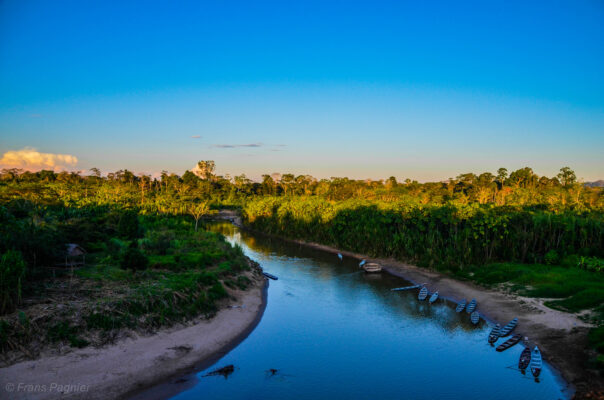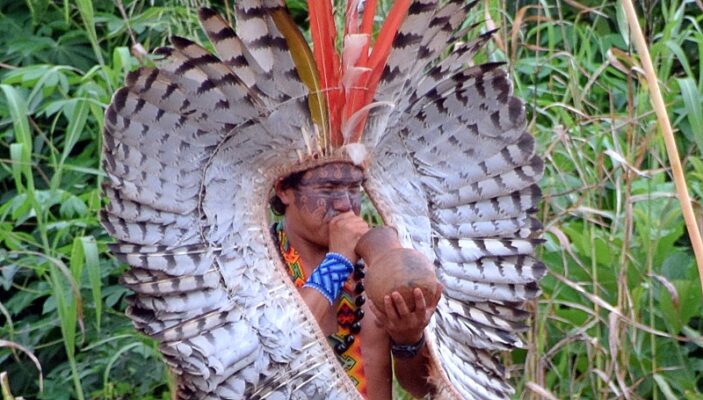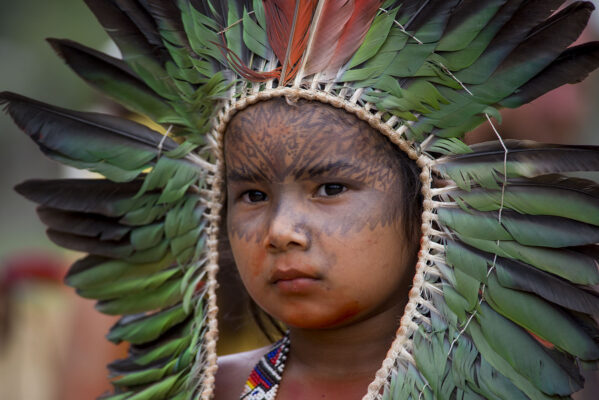The Yawanawá tribe is a group of indigenous people who live in the Amazon rainforest of Brazil, occupying the Gregório River Indigenous Land. The Yawanawa have lived in harmony with the forest for thousands of years and have maintained their culture and traditions despite European colonisation.

The Yawanawa are from the Pano linguistic root like many of the tribes in Acre state of Brazil and also in Peru. They have strong family ties with related tribes such as the Katukina with whom they share their tribal lands on the Gregorio river, the Shawãdawa, the Yaminawá and others. Their name comes from the wild boar or white lipped peccary, in their language Yawa, Nawa means people. They have this name because traditionally they were a tight knit group that roamed in a close band like their name sake. The names of all the Pano tribes have significance to their social structure’s and spiritual heritage,
In the early 20th century, the beginning of the rubber boom, they made first contact with the white man and they started to work for them in the rubber extraction. This is what happened to most pano tribes and was a time of many tribes being exterminated or enslaved. The Yawanawa came to a point that there were only about 50 members of the tribe left. In the eighties they made a Yawanawa life plan and started to expel the rubber tappers, the evangelists and alcohol. With this they started to bring back their culture and spirituality. With that their sacred plant medicines such as Ayahuasca and Rapé and the practice of their initiation diets.
What is Yawanawá Rapé?
Rapé is a sacred medicine for the Yawanawa and an important part of their history. They called it Ruma, and according to their mythology, it originates from the first human to die, King Ruwa.
When they buried him, sacred plants, including the tobacco plant, grew over his body. The shaman ground it into a powder, and people used it for healing.
Chief Biraci was the first of the post rubber boom cultural revival to do an initiation diet and was one of the first to bring Rapé back to their culture, he is great story teller and maybe the person who knows best the traditions and myths of his people. He talks a lot about the history of Rapé and what it means in their culture. He explains it was first of all a tool to connect with their ancestors, have a look at the following video.
When the first white man came to their land, the chief offered him Rapé, as he wanted to see if this man was pure of heart. In their tradition, many medicines could be used for good or evil depending on the intentions of the person using them, but not Rapé; it could only be used for good.
(This is based on the Yawanawá mythology; please bear in mind that Rapé is a tobacco product, and care must be taken when using it.)

Yawanawá Shamanism
Yawanawá shamanism, despite its reputation for curing, used to be a more diverse tradition that involved more practical applications of shamanic knowledge. In terms of curing, the most common practice today is praying, known as shuãnka. During the healing sessions, the shaman takes ayahuasca and recites over a pot of manioc caiçuma (a fermented beverage) from which the patient will later drink.

Shamans are traditional healers in the Amazon, and their diagnosis of illnesses is based on patients’ dreams. Different shamanic techniques exist, and various names designate each type of specialist: yuvehu, kushuintia, and shuintia.
Shamanic initiation is a process that involves four processes:
- The undertaking of certain trials, which can be understood as a sort of test to see if the individual has what it takes to become a shaman
- The fulfilment of strict periods of precautionary measures. This means that the individual must abstain from certain activities and behaviours while they are in training
- The ingestion of various kinds of hallucinogenic substances
- Learning the specific knowledge involved in the curing chants and ‘prayers’
Yawanawa Tribal lands
The Yawanawá people are an indigenous tribe that lives in the southern part of the Gregório River Indigenous land, sharing 200,000 hectares with the Katukina people of Sete Estrelas village.

The Yawanawa live for a big part from sustainable agriculture, fishing and hunting. Fishing and hunting are both a large part of the Yawanawá culture. The whole community takes part in fishing trips in the dry season, which become food festivals.
The Yawanawá festival is an opportunity to celebrate their culture through food, dance, and faith rituals, and the Sacred Snuff Yawanawa Rapé will also be consecrated at these festivals.
They are known for their beautiful handicrafts such as their beadwork bracelets and earrings. The Yawanawa language is taught in their schools to the children.
Indigenous rights
This is when the indigenous rights movement started in Brasil and people like Biraci Yawanawa, Siã Huni Kuin, Airton Krenak and people like that started to speak up for their people.
They still fight for their rights to exist and continue to have a strong voices such as Chief Biraci Nixiwaka Yawanawa, Laura Yawanawa and Tashka Yawanawa in the indigenous rights movement in Brazil.